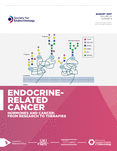WOMEN IN CANCER THEMATIC REVIEW: Circadian rhythmicity and the influence of ‘clock’ genes on prostate cancer
- 1VA Northern California Health Care System, Mather, California, USA
- 2Department of Urology, University of California at Davis, Sacramento, California, USA
- 3Department of Biochemistry and Molecular Medicine, University of California at Davis, Sacramento, California, USA
- Correspondence should be addressed to P M Ghosh; Email: paghosh{at}ucdavis.edu
Abstract
The androgen receptor (AR) plays a key role in the development and progression of prostate cancer (CaP). Since the mid-1990s, reports in the literature pointed out higher incidences of CaP in some select groups, such as airline pilots and night shift workers in comparison with those working regular hours. The common finding in these ‘high-risk’ groups was that they all experienced a deregulation of the body’s internal circadian rhythm. Here, we discuss how the circadian rhythm affects androgen levels and modulates CaP development and progression. Circadian rhythmicity of androgen production is lost in CaP patients, with the clock genes Per1 and Per2 decreasing, and Bmal1 increasing, in these individuals. Periodic expression of the clock genes was restored upon administration of the neurohormone melatonin, thereby suppressing CaP progression. Activation of the melatonin receptors and the AR antagonized each other, and therefore the tumour-suppressive effects of melatonin and the clock genes were most clearly observed in the absence of androgens, that is, in conjunction with androgen deprivation therapy (ADT). In addition, a large-scale study found that high-dose radiation was more effective in CaP patients when it was delivered before 17:00 h, compared with those delivered after 17:00 h, suggesting that the therapy was more effective when delivered in synchrony with the patient’s circadian clock. As CaP patients are shown to become easily resistant to new therapies, perhaps circadian delivery of these therapeutic agents or delivery in conjunction with melatonin and its novel analogs should be tested to see if they prevent this resistance.
- Received 12 September 2016
- Accepted 19 September 2016
- Made available online as an Accepted Preprint 22 September 2016
- © 2016 Society for Endocrinology












